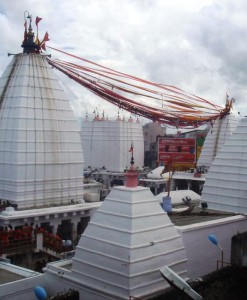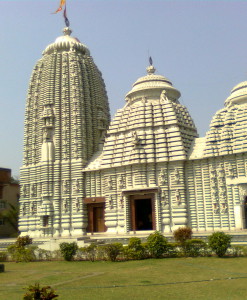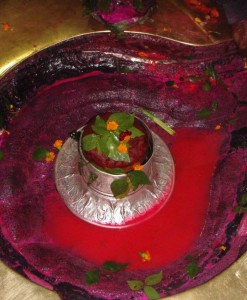No products in the cart.
Baidyanath Dham, Deoghar
Baidyanath dham is one of the twelve Jyotirlingas, the most sacred abodes of Shiva. It is located in Deoghar in Jharkhand, India. The temple complex comprises of the main temple and 21 other temples.
According to Hindu beliefs, the demon king Ravana worshipped Shiva at the current site of the temple to get the boons that he later used to wreak havoc in the world. Ravana offered his ten heads one after the another to Shiva as a sacrifice. Pleased with this, Shiva descended to cure Ravana who was injured. As he acted as a doctor, he is referred to as Vaidhya (“doctor”). From this aspect of Shiva, the temple derives its name.
Acording to the Shiv Purana, Ravana felt that his capital would be perfect and safe only if Shiv resided there. As a result, he began praying to the Lord. Impressed by his devotion, Lord Shiva gave Ravana a Shiva Lingam and told him to take it with him to Lanka. However, if on the way, Ravana were to stop anywhere and put the lingam down, it would get fixed permanently on that spot. Ravana was immensely happy as the lingam would protect his capital and decided to not put the lingam down anywhere.However, the other gods objected as if Ravana were to get the lingam in Lanka, he would turn invincible and would be able to wreck havoc in the world.
On his way back from Mount Kailash, Ravana needed to perform the sandya-vandana which he could not do with the lingam in one hand. He started searching for someone nearby who could hold the lingam for him. Ganesh appeared, disguised as a shepherd, and offered to hold the lingam. He however warned Ravana that if the latter took a large amount of time in getting back, he would leave the lingam on the ground and leave. Ravana agreed and left for his sandya-vandana. Ganesh pretended to be vexed by his delay in returning and left the lingam on the ground. When Ravan returned, he saw the lingam on the ground and despite his best efforts, he was unable to move it again. He left for Lanka without the lingam. The gods were happy that the Shiva linga did not reach Lanka and Ravana was unable to destroy the world
According to the Shiva Purana, once Lord Brahma and Vishnu had an argument in terms of supremacy of creation. In order to solve the dispute, Shiva decided to pierce the three worlds as an endless pillar of light. Both Vishnu and Brahma started upwards and downwards respectively to find the end of the light. Brahma lied that he had found the end while Vishnu accepted that he could not and accepted defeat. Shiva cursed Brahma that as punishment for lying to him, Brahma would not be part of any ceremonies while Vishnu would always be worshipped. The jyotirlinga is the supreme partless reality, out of which Shiva partly appears. The jyotirlinga shrines, thus are places where Shiva appeared as a fiery column of light. Each of the twelve jyotirlinga sites take the name of the presiding deity – each considered to be a different manifestation of Shiva. At all these sites, the primary image is the jyotirlingam representing the infinite nature of Shiva. The twelve jyotirlinga are Somnath in Gujarat, Mallikarjuna Jyotirlinga in Andhra Pradesh, Mahakaleswar in Madhya Pradesh, Omkareshwar in Madhya Pradesh, Kedarnath in Uttarakhand, Bhimashankar in Maharastra, Kashi Viswanath at Varanasi, Trimbakeshwar Shiva Temple in Maharastra, Baidyanath Dham in Jharkhand, Nageshwar at Dwarka, Rameshwar in Tamil Nadu and Grishneshwar in Maharastra.
On a normal day, the worshipping of the Jyotirlingam begins at 4 AM. The temple doors at Baidyanath Dham open at this time. The Head priest worships with Shodashopachar. Then the devotees begin their worship of the lingam.
The tradition is that the priests of the temple pour water upon the lingam first, later on other pilgrims pour water and offer flowers upon the lingam.
The Puja rituals continue till 3.30 PM After this the temple doors are closed.
In the evening at 6 PM the doors are opened again for devotees/ pilgrims and the process of worshipping begins. At this time, the Shringar Puja takes place.
Scent is spread over the lingam. Again a stream of water is poured over the lingam. Sandal paste of Malayagiri is also pasted on the head of the lingam.
Normally, at 9 PM the temple doors closes at the Baidyanath Dham.
During various religious occasions, the darshan timings are extended.
The importance of the Baidyanath dham is the most during the month of Shrawan. During this period, lakhs of devotees visit the temple. Most of them first visit Sultanganj, which is 105 km from Babadham.
In Sultanganj, the Ganges flows to the North. It is from this place that the devotees collect water in their kanwars and carry the holy Ganges water, with the kanwars on their shoulders. They walk 109 km up to Baidyanath dham at Babadham reciting Bol Bam on the way.
On reaching Babadham, the kanwarias first take a dip in the Shivaganga to purify themselves, and then enter the Baba dham, where the Ganges water is offered to the Jyotirlingam.
This pilgrimage continues during the whole of Shravan Maas for 30 days, during July-August. This is the longest religious fair in the world.
People from foreign lands also visit Babadham not only during Shravan month but also during the rest of the year.
The sight on the way from Sultanganj to Babadham is of a 109 km long human chain of saffron clad pilgrims. It is estimated that within this period of one month around 50 to 55 lakhs pilgrims visit Babadham.
Besides the great pilgrimage during Shrawan, almost the whole year remains under fair with Shivaratri in March, Basant Panchami in January, Bhadra Purnima in September.
Baidyanath Dham in Deoghar is easily accessible through any of road, rail or by air.
Roadways
Deoghar is directly connected by road to Kolkata ( 373 km), Patna (281 km), (Ranchi 250 km). Regular buses ply from Deoghar to Dhanbad, Bokaro, Jamshedpur, Ranchi and Bardhaman (West Bengal). Private Vehicles are available for hire to and from any part of country.
The Main Bus Stand in Deoghar is located 1km from the Tower Chowk, the unofficial Center of Deoghar Town.
Railways
Deoghar is connected to New Delhi Howrah Main Line via Jasidih (7 km). Jasidih is well connected to cities like New Delhi, Calcutta, Mumbai, Chennai, Bhubaneswar, Raipur, Bhopal via rail route. There are trains linking Deoghar to Jasidih every hour in morning and evening and every few hours during day. Auto Rickshaws connecting Deoghar and Jasidih Railway Stations are available from 4AM to 11PM every 5 Minutes. A shared Auto usually charges Rs 5 for one person and Rs 100 when reserved.
A separate Railway Station has been built up in the North Deoghar area, near Nandan Pahar which links Jasidih to Dumka. A new Railway line connecting Deoghar to Sultanganj is under construction.
Airways
Deoghar International Airport is presently under Construction. At present reaching Deoghar via Flight is limited to Patna (PAT), Kolkata (CCU) or Ranchi (IXR). The nearest Airport is Patna from where you can take a Train Journey or hire a Taxi. A Taxi would cost you normally around Rs 3000 from Patna to Deoghar.
Baidyanath Dham, Deoghar, Jharkhand
One thought on “Baidyanath Dham, Deoghar”
Leave a Reply
You must be logged in to post a comment.






uiiutlglui